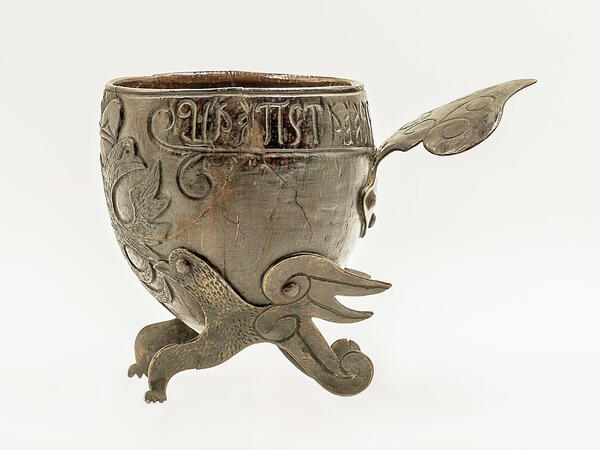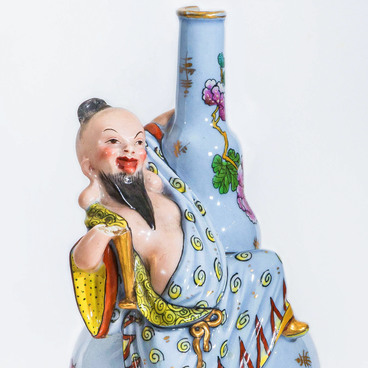The antique coconut cup on display at the museum is a replica of an 18th century piece. It was made a century later, in the 19th century. At that time, in the era of “historicism”, an archaicized objects were especially popular.
In Russia, coconuts were called “Indian nuts” because most often the they were brought from India. Coconut cups appeared in Russia in the 16th century, but they were not made here. The items were exported from Europe. Gradually, in the second half of the 17th century, Russian craftsmen learned to work with nut and began to make bowls themselves. The cups were often given as gifts for family celebrations, anniversaries and as prizes. The coconut itself, however, was still a rare imported fruit.
The bowl from the collection of the museum belonged to Dmitry Mamin-Sibiryak. The bowl is covered with black paint on top, and its legs were made of copper in the shape of two fantastic birds. The handle was made in the same style, in the form of an exotic animal’s tail, and decorated with a painted ornament. There is a small crack on the right side of the exhibit.
The writer Dmitry Mamin-Sibiryak collected unusual things and historical relics. He often brought them back from his travels, or received as a gift from friends who knew about his hobby. The coconut bowl was a part of his collection.
After Mamin-Sibiryak’s death, the exhibit stayed with his wife, Olga Guvale, (married name Mamina). She graduated from the Women’s Patriotic Institute and worked as a tutor for the writer’s daughter, Yelena Mamina. From 1894, she lived in the house of Dmitry Mamin-Sibiryak. They started dating, and in 1900, they got married. Since then, Guvale replaced the girl’s mother.
In 1916, the writer’s wife gave the exhibit to the Ural Society of Natural Science Lovers. Later, his collection became the part of the Sverdlovsk Regional Museum of Local History, where the coconut cup was kept until 1946. Then together with other rarities from Mamin-Sibiryak’s collection, it was transferred to the house-museum. Now these items are kept in the St. Petersburg room.
In Russia, coconuts were called “Indian nuts” because most often the they were brought from India. Coconut cups appeared in Russia in the 16th century, but they were not made here. The items were exported from Europe. Gradually, in the second half of the 17th century, Russian craftsmen learned to work with nut and began to make bowls themselves. The cups were often given as gifts for family celebrations, anniversaries and as prizes. The coconut itself, however, was still a rare imported fruit.
The bowl from the collection of the museum belonged to Dmitry Mamin-Sibiryak. The bowl is covered with black paint on top, and its legs were made of copper in the shape of two fantastic birds. The handle was made in the same style, in the form of an exotic animal’s tail, and decorated with a painted ornament. There is a small crack on the right side of the exhibit.
The writer Dmitry Mamin-Sibiryak collected unusual things and historical relics. He often brought them back from his travels, or received as a gift from friends who knew about his hobby. The coconut bowl was a part of his collection.
After Mamin-Sibiryak’s death, the exhibit stayed with his wife, Olga Guvale, (married name Mamina). She graduated from the Women’s Patriotic Institute and worked as a tutor for the writer’s daughter, Yelena Mamina. From 1894, she lived in the house of Dmitry Mamin-Sibiryak. They started dating, and in 1900, they got married. Since then, Guvale replaced the girl’s mother.
In 1916, the writer’s wife gave the exhibit to the Ural Society of Natural Science Lovers. Later, his collection became the part of the Sverdlovsk Regional Museum of Local History, where the coconut cup was kept until 1946. Then together with other rarities from Mamin-Sibiryak’s collection, it was transferred to the house-museum. Now these items are kept in the St. Petersburg room.



